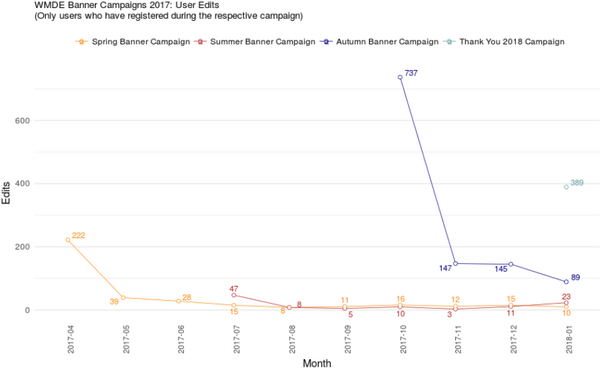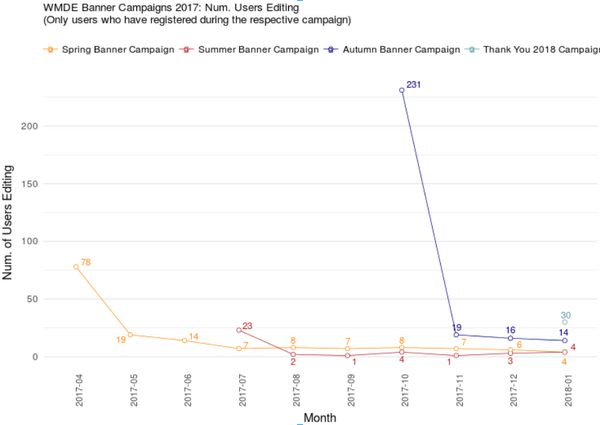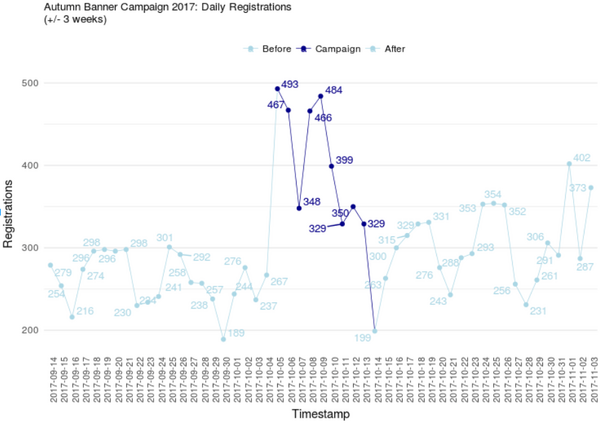Wikimedia Deutschland/new-editors/2017 Campaigns Evaluation
Overview |
Activities |
Associated Research |
Available Materials for Adoption |
Go back to 'Key Findings and Results' overview page.
2017 Campaigns Evaluation
[edit]What information is on this page?
[edit]In 2017, WMDE was commissioned by the general meeting to convince enough people by the means of online campaigning to become active editors of Wikipedia and thereby contribute to stop the decline in authors.
Instead of just one, we conducted five campaigns in total, and reported on these on this portal. What is our overall conclusion? Are on-wiki campaigns a useful tool to recruit new editors for Wikipedia? What can be achieved and where are the limits?
We would like to give answers to these questions and more and invite you to join the discussion on the discussion page.
Summary
[edit]Among Wikipedia readers, there is still too little awareness about the nature of the online encyclopedia as a large community project in which anybody can contribute. But even when they are aware of that fact, many shy away from contributing, because they believe that only expert knowledge gives them license to do so, or they don’t know how to contribute, and that they can also contribute on a small scale.
With online campaigns, we are taking the first step. We are raising awareness, we are able to interest readers in contributing, and perhaps we can even motivate people to register a user account. Creating a user account is easy, becoming a Wikipedia author is not. It requires to learn the encyclopedic and practical rules, but also the (unwritten) cultural norms. For the first two areas, there is a need for different, but in any case easily accessible learning opportunities. Some of those we tested in 2017. Conveying the cultural norms, i.e. how collaboration in Wikipedia works, can only be achieved within the community.
1,531 additional users in 2017
[edit]| 'Thank You!' Banner 2017 (Dankesbanner 2017) | Spring | Summer | Fall | SUM 2017 | 'Thank You!' Banner 2018 (Dankesbanner 2018) | |
|---|---|---|---|---|---|---|
| Registrations | (technically, a monitoring of registrations is not yet possible) | 319 | 158 | 1,054 | 1,531 | 120 |
| Banner Impressions | 7.5 Mio | 12 Mio | 8.8 Mio | 28.3 Mio | 16.2 Mio | |
| Campaign Duration | 11 Days | 8 Days | 9 Days | 28 Days | 14 Days |
Throughout 2017, we ran five campaigns. The numbers are not directly comparable, as the banner display rate was gradually increased. Still, we now have solid empirical values regarding which number of registrations is to be expected at which banner display rate. Our current experiences with a maximum display rate of optimized banners also show that there is apparently a limit to the number of registrations that can be achieved with a campaign (Fall Campaign).
Long-term effects – Activity of new users
[edit]The online campaigns of the sort we have been running since 2017, are apparently quite suited for motivating readers of Wikipedia to register a user account. Some of these new users actually begin to edit. We assume that roughly after the tenth edit, there is a basic understanding of contributing to Wikipedia.
Diagram 1: Total number of edits of users over time per campaign
Surprisingly few edits made by the new editors were reverted. This means that the new users generally come in with good intentions and understand relatively quickly how contributing works.
Reverted edits per campaign [Time span: From the beginning of the campaign until January 2018]
| Campaign | Total number of edits per campaign | Total number of reverted edits per campaign
(% of total edits) |
|---|---|---|
| Spring Banner Campaign | 376 | 2 (0.53%) |
| Summer Banner Campaign | 107 | 3 (2.80%) |
| Autumn Banner Campaign | 1118 | 11 (0.98%) |
| Thank You 2018 Campaign | 389 | 3 (0.77%) |
Nevertheless, becoming an active author is a long journey. Aside from a few exceptions, new users generally only edit occasionally, not daily or several times per week. Getting to know one’s way around Wikipedia seems to be a longer process. Recent findings from the accompanying research confirm this assumption.
This finding cannot just be observed in the first diagram of all edits, but also in the following diagrams. They show that while in the beginning of the campaigns, some users have reached their tenth edit, but that this number declines strongly over time. Simultaneously, a long-term effect of the campaigns can be observed, showing new users who reach their tenth edit at a later point.
Users who have reached their tenth edit over time per campaign
Number of users who edited during the respective month per campaign (Example: This diagram shows that nineteen users who registered during the fall campaign made one or more edits in November.)
Number of users who made five or more edits in the respective month per campaign (Example: This diagram shows that seven users who registered during the fall campaign made five or more edits in November.)
Campaigns make a difference
[edit]User:Dr. Bernd Groß painstakingly compared the registration numbers during the Summer Campaign with ‘normal’ registrations. We took up this idea and checked across campaigns, whether there was a notable increase in registration numbers during the placement of banners.
That was indeed the case. It can be seen in the higher number of registrations (per day) during the campaign flight. It was most apparent in the Fall Campaign, which had by far the highest banner display rate of all campaigns up to this point.
We did indeed reach readers who would otherwise possibly not have registered, or we created an additional impulse to do so. This is consistent with results gathered so far from our additional qualitative research: Far too few readers are aware of the fact that anybody can contribute to Wikipedia. Online banners are a way to educate people about Wikipedia.
Registrations for the campaigns over time (three weeks prior and after)
| Campaign | -3 Weeks | Campaign Duration | +3 Weeks | Registrations via the campaign | Share (%) of registrations via the campaign in the total number of registrations during the campaign duration |
|---|---|---|---|---|---|
| Spring
(Registrations per day) |
257 (Reg./d) | 305 (Reg/d) | 301 (Reg./d) | ||
| (Total number of registrations) | 3596 (14 d)
no earlier data available |
3357 (11d) | 6314 (21d) | 318 | 9.47% |
| Summer
(Registrations per day) |
246 (Reg./d) | 281 (Reg./d) | 244 (Reg./d) | ||
| (Total number of registrations) | 5164 (21d) | 2249 (8d) | 5133 (21d) | 159 | 7.07% |
| Fall
(Registrations per day) |
261 (Reg./d) | 407 (Reg./d) | 300 (Reg./d) | ||
| (Total number of registrations) | 5475 (21d) | 3665 (9d) | 6303 (21d) | 1054 | 28.76% |
| Thank You! Banner 2018
(Registrations per day) |
284 (Reg./d) | 385 (Reg./d) | 172 (Reg./d) | ||
| (Total number of registrations) | 5963 (21d) | 5385 (14d) | 3606 (21d) | 121 | 2,25% |
Spring Campaign
Summer Campaign
Fall Campaign
Banners are not enough
[edit]Banners are but the first step to get the attention of readers. Through the landing pages behind the different banners, we offered a point of entry and a pathway to learning to interested users. Due to testing purposes, however, we only offered one opportunity to learn per banner. These included, for example, a guided tour or how-to videos. After that one learning opportunity, the new users were on their own. Many new users who registered through the banner made one or two edits and then stopped again.
We do know that introductory aids are useful, but we are not yet able to tell which ones and how often they are needed by new users, as the number of users is generally not very high and does therefore not provide a reliable data set regarding a concrete effectiveness (compare the observations of the guided tours from the Spring and Summer Campaign.
| Phase | Awareness | Onboarding/ Learning rules | Onboarding/ Community participation | Complexy tasks | ... |
|---|---|---|---|---|---|
| Medium | Banner | Videos, Tours, Tutorials, Help pages | |||
| Learning path | Data analysis | qual. / quant. research |
The breakdown is one possible way to look at the pathway, based on the WMF’s approach, and does not make any absolute claims.
With a view to providing optimal support for new users on their way to becoming an editor, we just made a first step with our campaigns.
What worked, and what did not?
[edit]Throughout the course of the campaigns, we realized that clicking on banners should ideally lead to a brief landing page explaining the message of the button some more. Both our figures for registrations and numbers of edits, plus accompanying and previously existing research support the assumption that concrete and as simple as possible tasks are needed to encourage new users to dare to make their first edit. That might be the correction of an error, or updating an outdated piece of information within an article.
Regarding the style, while readers do for all intents and purposes like colorful and contrast-heavy banners, they should still appear serious, in order to represent Wikipedia’s image. This is supported not just by the pure numbers of clicks, but also by the results from a pretest during the fall campaign, which asked potential audiences about their opinion.
Beyond this, we observed that over time, the numbers of edits made by new users who registered during a campaign is increasing. This suggests that the impact of the campaigns also takes effect over time.
Average number of edits per campaign after 2, 3, and 4 months
(average number of edits made by all users, who registered during the respective campaign, at a certain point)
Involving the Community
[edit]During the planning of online campaigns, as well as the respective support offers that were tested, we shared our initial reasoning and the plans for implementation with the community and asked for feedback. We aim to continue on this path, as it has proven to be effective, and the preliminary discussions helped us to continually implement better campaigns.
Especially regarding supporting materials such as videos, trainings, or the guided tours, we are able to build and test prototypes and samples. However, the dissemination, improvement, and embedding into Wikipedia is incumbent upon the community.
Outlook for 2018
[edit]For 2018, we plan to continue to inspire people to contribute to Wikipedia. For this purpose, we intend to work with online campaigns again. We aim to increasingly focus on making the entry into active participation in Wikipedia easier for new users. Towards this objective, we interviewed potential editors at the beginning of the year in order to find out more about their needs regarding information and support offers at the starting point. Based on this information, we seek to put our focus on those supporting measures in 2018. You can find the evaluation of the survey here (in German). Beyond that, we will make further research efforts towards finding out whether there are hurdles for new editors or continuing editorship that can be reduced.
Contributions from the Community
[edit]We are looking forward to an open exchange of ideas regarding online campaigns. Therefore, we invite you to add information and amend contributions. Please use the discussion page and this section for opinions and ratings, for example to add numbers and information.
Back to top
Go back to 'Key Findings and Results' overview page.








